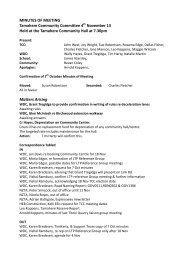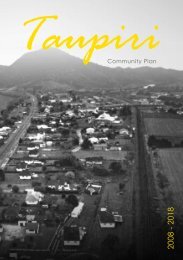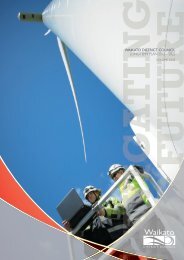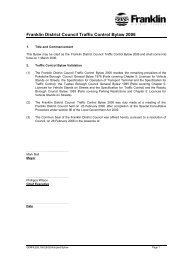1.2 Purpose of this waste assessment - Waikato District Council
1.2 Purpose of this waste assessment - Waikato District Council
1.2 Purpose of this waste assessment - Waikato District Council
- No tags were found...
You also want an ePaper? Increase the reach of your titles
YUMPU automatically turns print PDFs into web optimized ePapers that Google loves.
EstimatedpopulationJune 2010boundaries2001 2002 2003 2004 2005 2006 2007 2008 2009 201045,400 47,600 48,300Source: www.stats.govt.nz, subnational population estimatesStatistics New Zealand has updated its population estimates to reflect the 1 November 2010 boundarychanges. This shows an estimated increase in population following the boundary changes <strong>of</strong> 15,500.Despite uncertainties around the current population and predicted growth in the district, it is very likely thatgrowth will continue, and current indications are that <strong>this</strong> growth will accelerate over the next 20 years.Analysis by the council in partnership with the University <strong>of</strong> <strong>Waikato</strong> have resulted in the predictions forpopulation shown below.Table 20: Forecasted district populationEstimated populationNov 2010 boundaries2009 2010 2011 2012 2021 2022 203162,800 63,800 64,066 65,081 75,740 76,997 86,982Growth (%) 1.6% 1.6% 0.42% 1.6%Estimated populationJune 2010 boundariesSource: <strong>Waikato</strong> <strong>District</strong> <strong>Council</strong>47,600 48,30016.4%(tenyears)1.7%13.0%(nineyears)The ethnic makeup <strong>of</strong> the district is unlikely to change significantly following the boundary changes. In 2009, thedistrict’s population was 69 per cent European (compared to 67.6 per cent across New Zealand) and 25.9 percent Maori (14.6 per cent across New Zealand). The remainder were <strong>of</strong> Pacific and Asian origin.6.<strong>1.2</strong> Commercial activityAs noted in section 5.0 the <strong>Waikato</strong> district is home to a number <strong>of</strong> large <strong>waste</strong> facilities, including HamptonDowns landfill, Envir<strong>of</strong>ert and Lowe Corp. Significant amounts <strong>of</strong> <strong>waste</strong> move in to the district fromsurrounding areas as a result. The <strong>waste</strong> industry has not previously been specifically recognised as an industrialsector in documents such as the <strong>Waikato</strong> <strong>District</strong> Growth Strategy (2009), although other industries such asdairy, coal mining, and forestry are mentioned.The role the district has as a key transport and energy corridor between the three urban centres <strong>of</strong> Tauranga,Hamilton and Auckland is also seen as a key factor in the location <strong>of</strong> commercial and industrial activity in thedistrict.The implications for <strong>waste</strong> management demand are two-fold: firstly the presence <strong>of</strong> strong industrial sectorrepresents <strong>waste</strong> streams that requirement management and secondly, the presence <strong>of</strong> such significant <strong>waste</strong>facilities presents the council with a number <strong>of</strong> options for managing <strong>waste</strong> in the district.A potentially negative outcome in terms <strong>of</strong> <strong>waste</strong> minimisation is the ease by which <strong>waste</strong> can be transportedand disposed <strong>of</strong> in a private facility without needing to pass through bulking or transfer stations, therebyreducing the options and degree to which the council can influence the management <strong>of</strong> these <strong>waste</strong> streams.This issue comes into particularly sharp focus with respect to cleanfill activity. Because <strong>of</strong> its proximity toAuckland it is likely that a substantial proportion <strong>of</strong> cleanfill type material from construction and demolition typeactivity makes is transported into the district. As much <strong>of</strong> <strong>this</strong> activity is uncontrolled there is no way <strong>of</strong> beingcertain <strong>of</strong> the extent <strong>of</strong> the issue, although anecdotal reports suggest that there is cause for concern and thelikelihood is that non-cleanfill type material is being disposed <strong>of</strong> to uncontrolled sites in the district.38
















